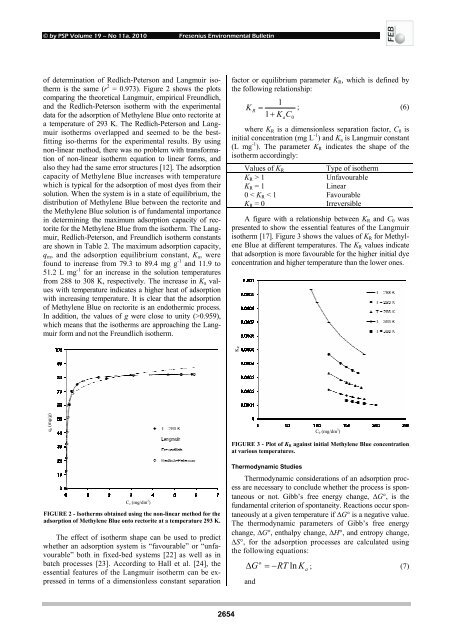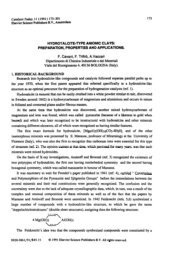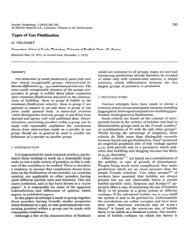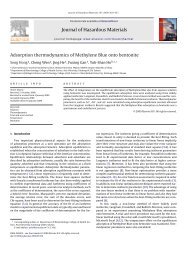equilibrium and thermodynamic parameters of adsorption
equilibrium and thermodynamic parameters of adsorption
equilibrium and thermodynamic parameters of adsorption
You also want an ePaper? Increase the reach of your titles
YUMPU automatically turns print PDFs into web optimized ePapers that Google loves.
© by PSP Volume 19 – No 11a. 2010 Fresenius Environmental Bulletin<br />
<strong>of</strong> determination <strong>of</strong> Redlich-Peterson <strong>and</strong> Langmuir isotherm<br />
is the same (r 2 = 0.973). Figure 2 shows the plots<br />
comparing the theoretical Langmuir, empirical Freundlich,<br />
<strong>and</strong> the Redlich-Peterson isotherm with the experimental<br />
data for the <strong>adsorption</strong> <strong>of</strong> Methylene Blue onto rectorite at<br />
a temperature <strong>of</strong> 293 K. The Redlich-Peterson <strong>and</strong> Langmuir<br />
isotherms overlapped <strong>and</strong> seemed to be the bestfitting<br />
iso-therms for the experimental results. By using<br />
non-linear method, there was no problem with transformation<br />
<strong>of</strong> non-linear isotherm equation to linear forms, <strong>and</strong><br />
also they had the same error structures [12]. The <strong>adsorption</strong><br />
capacity <strong>of</strong> Methylene Blue increases with temperature<br />
which is typical for the <strong>adsorption</strong> <strong>of</strong> most dyes from their<br />
solution. When the system is in a state <strong>of</strong> <strong>equilibrium</strong>, the<br />
distribution <strong>of</strong> Methylene Blue between the rectorite <strong>and</strong><br />
the Methylene Blue solution is <strong>of</strong> fundamental importance<br />
in determining the maximum <strong>adsorption</strong> capacity <strong>of</strong> rectorite<br />
for the Methylene Blue from the isotherm. The Langmuir,<br />
Redlich-Peterson, <strong>and</strong> Freundlich isotherm constants<br />
are shown in Table 2. The maximum <strong>adsorption</strong> capacity,<br />
qm, <strong>and</strong> the <strong>adsorption</strong> <strong>equilibrium</strong> constant, Ka, were<br />
found to increase from 79.3 to 89.4 mg g -1 <strong>and</strong> 11.9 to<br />
51.2 L mg -1 for an increase in the solution temperatures<br />
from 288 to 308 K, respectively. The increase in Ka values<br />
with temperature indicates a higher heat <strong>of</strong> <strong>adsorption</strong><br />
with increasing temperature. It is clear that the <strong>adsorption</strong><br />
<strong>of</strong> Methylene Blue on rectorite is an endothermic process.<br />
In addition, the values <strong>of</strong> g were close to unity (>0.959),<br />
which means that the isotherms are approaching the Langmuir<br />
form <strong>and</strong> not the Freundlich isotherm.<br />
q e (mg/g)<br />
C e (mg/dm 3 )<br />
FIGURE 2 - Isotherms obtained using the non-linear method for the<br />
<strong>adsorption</strong> <strong>of</strong> Methylene Blue onto rectorite at a temperature 293 K.<br />
The effect <strong>of</strong> isotherm shape can be used to predict<br />
whether an <strong>adsorption</strong> system is “favourable” or “unfavourable”<br />
both in fixed-bed systems [22] as well as in<br />
batch processes [23]. According to Hall et al. [24], the<br />
essential features <strong>of</strong> the Langmuir isotherm can be expressed<br />
in terms <strong>of</strong> a dimensionless constant separation<br />
2654<br />
factor or <strong>equilibrium</strong> parameter KR, which is defined by<br />
the following relationship:<br />
K<br />
1<br />
= ; (6)<br />
R<br />
1+<br />
KaC<br />
0<br />
where KR is a dimensionless separation factor, C0 is<br />
initial concentration (mg L -1 ) <strong>and</strong> Ka is Langmuir constant<br />
(L mg -1 ). The parameter KR indicates the shape <strong>of</strong> the<br />
isotherm accordingly:<br />
Values <strong>of</strong> KR<br />
Type <strong>of</strong> isotherm<br />
KR > 1 Unfavourable<br />
KR = 1 Linear<br />
0 < KR < 1 Favourable<br />
KR = 0 Irreversible<br />
A figure with a relationship between KR <strong>and</strong> C0 was<br />
presented to show the essential features <strong>of</strong> the Langmuir<br />
isotherm [17]. Figure 3 shows the values <strong>of</strong> KR for Methylene<br />
Blue at different temperatures. The KR values indicate<br />
that <strong>adsorption</strong> is more favourable for the higher initial dye<br />
concentration <strong>and</strong> higher temperature than the lower ones.<br />
K R<br />
FIGURE 3 - Plot <strong>of</strong> KR against initial Methylene Blue concentration<br />
at various temperatures.<br />
Thermodynamic Studies<br />
Thermodynamic considerations <strong>of</strong> an <strong>adsorption</strong> process<br />
are necessary to conclude whether the process is spontaneous<br />
or not. Gibb’s free energy change, ∆G°, is the<br />
fundamental criterion <strong>of</strong> spontaneity. Reactions occur spontaneously<br />
at a given temperature if ∆G° is a negative value.<br />
The <strong>thermodynamic</strong> <strong>parameters</strong> <strong>of</strong> Gibb’s free energy<br />
change, ∆G°, enthalpy change, ∆H°, <strong>and</strong> entropy change,<br />
∆S°, for the <strong>adsorption</strong> processes are calculated using<br />
the following equations:<br />
o<br />
∆ G = −RT<br />
ln K a ; (7)<br />
<strong>and</strong><br />
C 0 (mg/dm 3 )





